Click on an area of the map to view the artwork
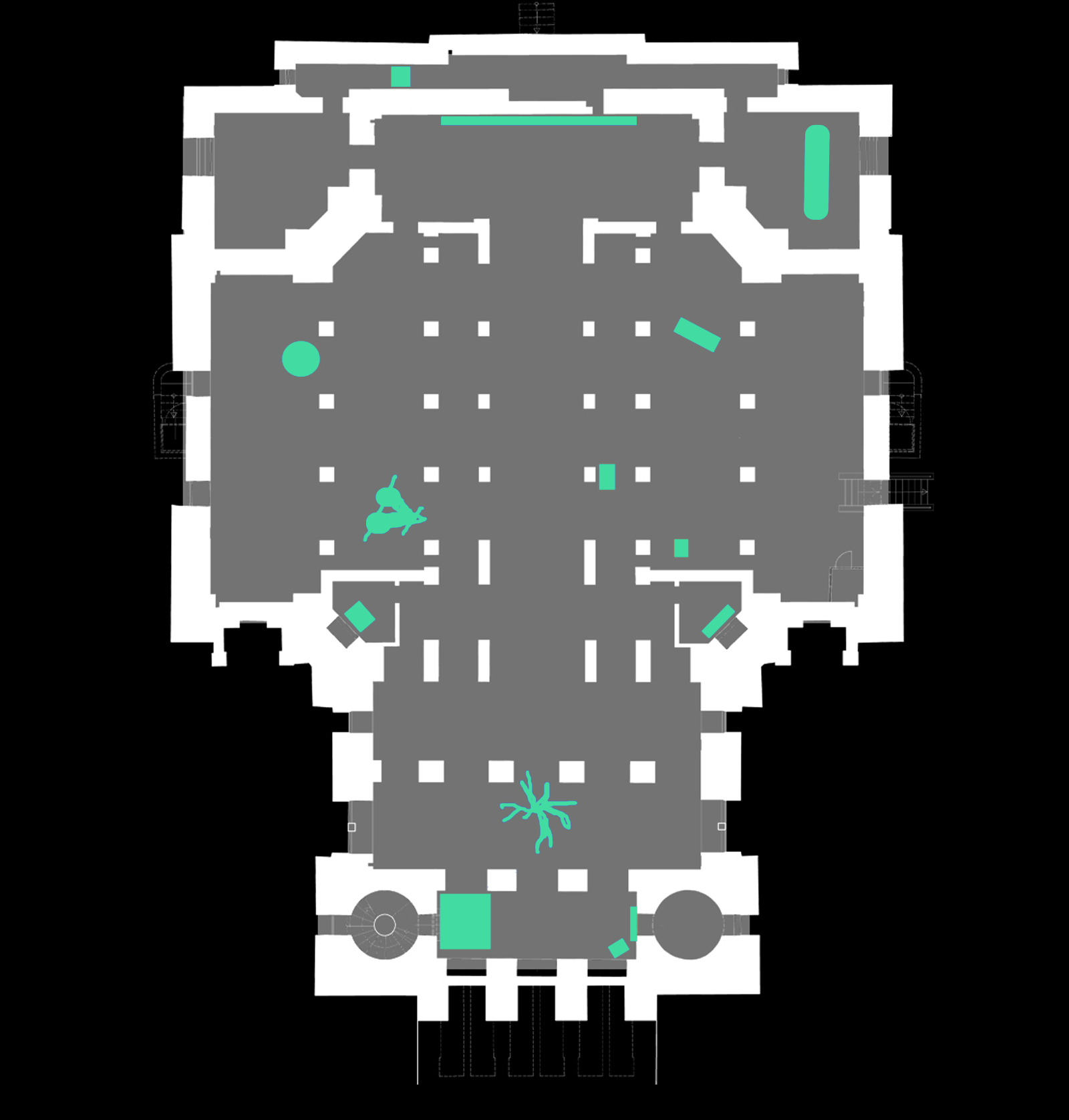
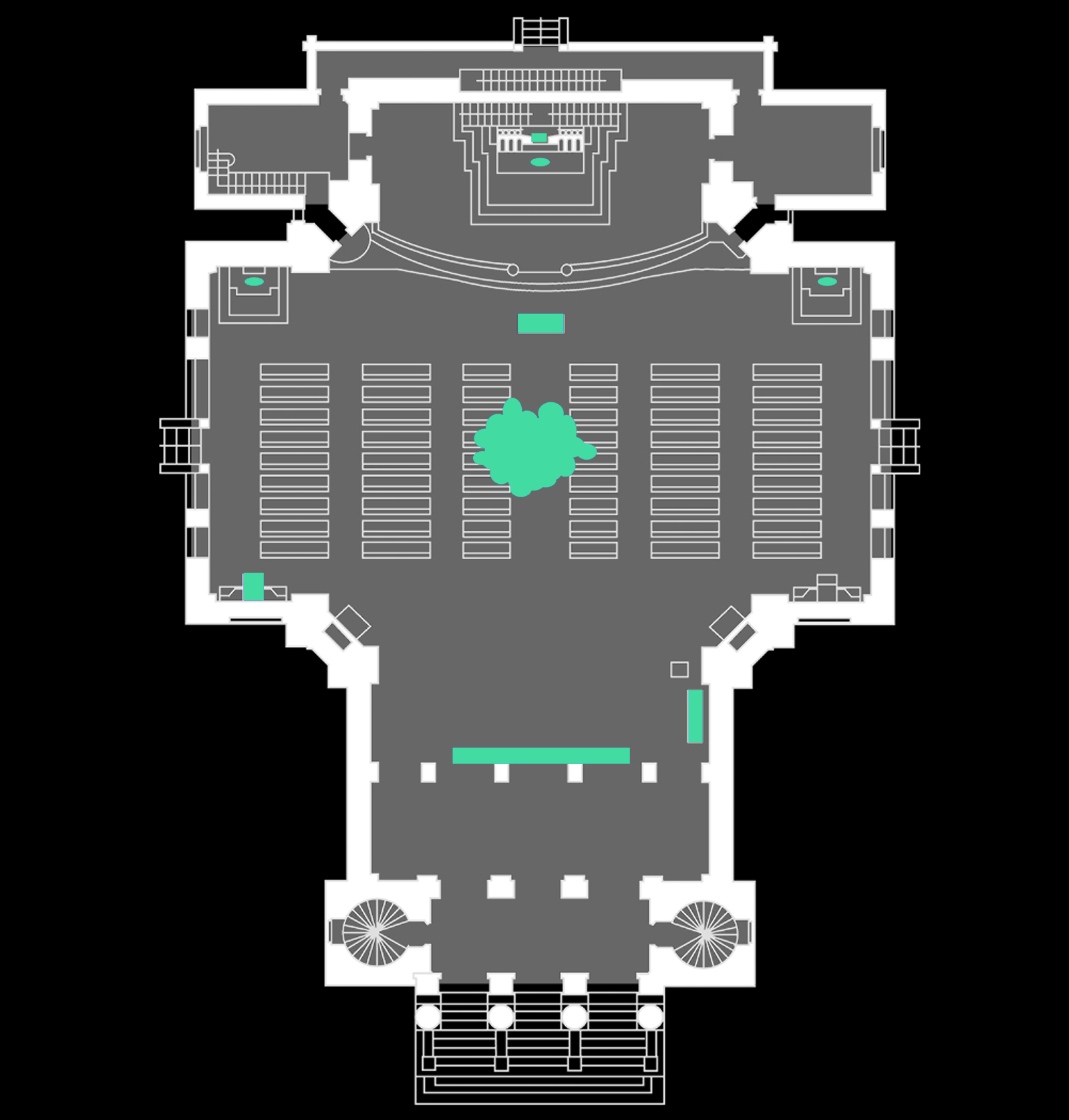


,_1977_(c)_LIMA_(installation).jpg )
This three minute video features the artist telling an anecdote about a session with her psychiatrist projected onto a twenty centimeter high white clay figure. The anecdote involves the artist mentioning to her therapist that she noticed lip marks on a mirror and then, upon returning the following week, seeing they had disappeared. Initially, the psychiatrist questioned the artist’s perception and in what turned out to be the final session, admits that she learned of her 12-year-old daughter kissing the mirror. The therapist couldn’t see these marks from where she was sitting, and the maid had cleaned the mirror on Fridays. Anderson eventually comes to the conclusion that she and the psychiatrist see things from a totally different angle, both literally and figuratively. From then on, visiting the psychiatrist becomes superfluous.
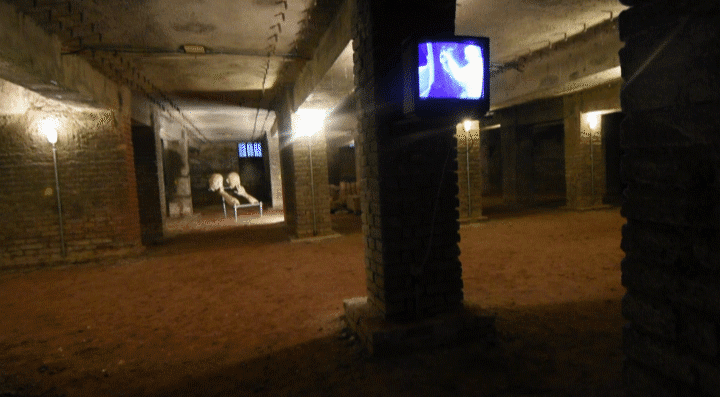
Art should not need to be explained. The silent video is a documentation of one of the most significant performance artworks by Joseph Beuys in Dusseldorf in 1965. At the beginning of the performance Beuys locked the gallery doors from the inside, leaving the gallery-goers outside. They could observe the scene within only through the windows. With his head entirely coated in honey and gold leaf, he began to explain pictures to a dead hare. Whispering to the dead animal on his arm in an apparent dialog, he processed through the exhibit from artwork to artwork. Occasionally he would stop and return to the center of the gallery, where he stepped over a dead fir tree that lay on the floor. After three hours the public was let into the room. Beuys sat upon a stool in the entrance area with the hare on his arm and his back to the onlookers. He ironically celebrated the ritual of “explaining art” with an action that was, for his viewers, effectively silent.
.jpg )
The sculpture features two arms aggressively grabbing the mouths of two men. The extended arms are clearly from a third person and can be seen as either violent or disciplinary, serious or playful. When the viewer cannot see anything playful about the work, the two individuals appear to be chastised or silenced. When the arrangement of heads and hands appears playful, the extended fingers seem curious and the faces seem complicit. The possibility of two dramatically different readings of the sculpture is an important work in the exhibition, as the viewer considers the variety of ways we can respond to experience of being restrained or interfered with. The work can be a representation of torment or playful reassurance.
_(3).jpg )
This sculptural arrangement features seven large scale sewing needles made from polyester resin. Each of the needles is the precise length corresponding to the height of the artist. The needle is both a symbol of pain and of repair. It can puncture the skin thus causing a wound and it can also be used to stitch the wound closed to facilitate healing.
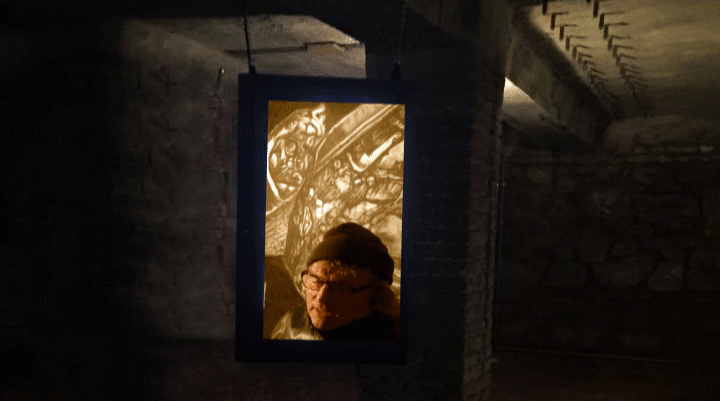
This three minute video features the artist reading a poem about his involuntary admission to a psychiatric hospital in 1981. The artist presented himself with severe anxiety at the emergency room of a hospital in Australia and was consequently committed. The artist stands in dim light in front of a black background and the image of his face gradually comes into focus.
.jpg )
This three minute video projection features photographs of details of Matthias Grünewald’s Isenheim Altarpiece. Images alternate between disturbing creatures that surround and torment the saint in the panel depicting ‘The Temptation of St. Anthony ‘and close-ups of the plants used to heal patients suffering from Ergotism (Saint Anthony’s fire) at the bottom of the panel depicting ‘St. Anthony’s visit to St. Paul in the wilderness.’ Small seedlings are placed under the volksaltar of the Kirche am Steinhof as if to be used as an offering. The plants are those depicted in the Isenheim altarpiece which were used to treat people suffering from Saint Anthony’s Fire, a condition which caused horrific hallucinations, mania and psychosis. Plaintain, Buckhorn, Verbena, Long-headed poppy and Bulbous buttercup were used to treat Saint Anthony’s fire while Austrian speedwell, Cross-leaved gentian, White swallowwart and White clover were used to treat the often foul and putrid wounds that afflicted those suffering from the condition.
.jpg )
Hans Ahnert worked as a surgeon in a hospital in Switzerland before deciding to turn his attention toward making art. Having entertained the idea of becoming a psychiatrist it is interesting to see a work which deals directly with a particular mental illness. The work features a wall of cubed cushions fastened by blue straps. The arrangement of cushions could conjure up an association with the padded walls of a restraining room in prison or hospital. It might take the viewer a moment before realizing that words are spelled out by the position of the straps on the cushions. The first line of cushions spells V-A-L-I-U-M, the second P-R-O-Z-A-C and so forth. Each of the names of medications prescribed for Obsessive Compulsive Disorder (OCD).
,_1983,_KUNSTGLAUBE.gif )
This nine minute scene from Nostalghia features a man attempting to carry a lit candle cupped in his hand across a drained pool. The struggle to keep the flame lit while poised between wind and water is obviously a metaphor for life itself. According to Oleg Yankovsky , the actor who performed this scene, the director asked the actor to help him fulfill a grand idea to “display an entire human life in one shot, without any editing, from beginning to end, from birth to the very moment of death.” The final static composition features a Russian homestead nestled inside the ruins of San Galgano in Tuscany.
.jpg )
This six and a half minute film is designed to simulate a psychotic event developed by Janssen after five years of research on actual patient cases. The viewer is led through a point-of-view series of auditory and visual hallucinations while alone in a house. For people who have never experienced a psychotic event, gaining an understanding of the distorted reality involved in psychosis can promote sympathy for those suffering from hallucinations and can also be an enlightening experience. Visitors to the exhibition will only be able to experience this work by requesting headphones from the exhibition staff. Without hearing the audio for this video, the work has no risk of causing disturbance. The video begins with a safety disclaimer and the room in which it will be installed will have clear instructions and a warning. The exhibition staff will recommend that visitors with a history of mental illness refrain from watching the video and use their discretion in allowing the use of headphones.
.jpg )
Matthew Silver is a New York based artist who performs madness on the streets and in public squares. He describes himself as a ‘village idiot’ and through his eccentric performance attempts to “parody excessive seriousness by playing with taboos, rules, and social norms.” In these two videos we can see both the performer and the philosopher who shares his wacky insights and profound thoughts while evoking smiles and laughter. These public performances effectively loosen people’s armour, opening a healthy space for imagination and creativity. The 2016 film ‘Being Vulnerable’ features the performer out of character, explaining the need to be vulnerable and to learn to be comfortable with vulnerability.
_NFB.jpg )
This fourteen minute animation is about Canadian animator Ryan Larkin, who had lived on skid row in Montreal as a result of drug and alcohol abuse. The distorted and disembodied appearance of the film’s characters is based on Landreth’s use of psychological realism to portray emotion visually. Trauma and emotional scars are visible as colours wrapping around the face, cavities in the head and exaggerated facial features.
,_2016_KUNSTGLAUBE_(foto-_KUNSTGLAUBE).jpg )
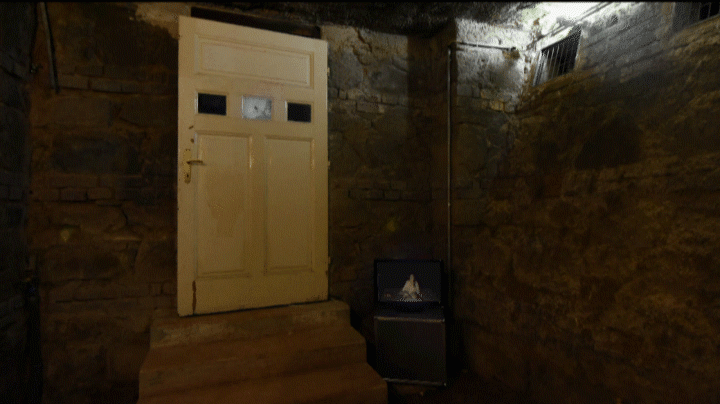
A performance on two screens looselybased on the script for Sarah Kane’s play by Stella Reinhold was recorded and then displayed on two screens. The monologue is an autobiographical portrayal of clinical depression, a very subjective presentation of depression. The decision for the performance to take place under the stairwell could be seen as a reference to the circular structure of the Narrenturm in Vienna.
.jpg )
The text for this musical composition is taken from the diaries and poems of Hans Peter Ilg, a Swiss man who has spent most of his life in a psychiatric hospital in Switzerland. The thirty five minute work will be played over the sound system in the church during the exhibition. The recording begins with an account of the trauma of the outsider poet’s birth followed by an account of major events that seem to have contributed toward his current experience of madness. The work transforms the handwritten autobiographical text into consoling song interrupted occasionally by disturbing and jarring sounds which correspond with the poet’s life story.
.jpg )
The two layers of illuminated stencils, meticulously cut from large sheets of plastic, depict the dining room at Neuschwanstein in Bavaria. The ‘mad’ King Ludwig II increasingly withdrew from day-to-day affairs of state in favour of extravagant artistic and architectural projects. Surrounding himself with opulence and decadence, he ultimately created a sanctuary for his eccentricities and madness. Creativity as an outlet for the stress that builds from an overwhelming feeling of being any kind of outsider is essential as a form of catharsis. Whether the artist himself labors away at the cutting table, getting lost in the process of making art, or the King commissions outlandish spaces for his own amusement, the creative process is an essential ingredient to maintaining and sustaining madness.
.jpg )
In 1970, the artist was admitted to the psychiatric hospital at Maria Gugging, Austria where he later became resident in the Haus der Künstler (House of Artists) connected to the hospital. Drawing and writing are intimately interwoven in his compositions, which gather together gods, demons, saints, prophets and miracle-workers. Walla also painted on the walls and furnishings of his room, on his belongings, and on the walls of both the hospital where he lived and the neighbouring houses. His works were talismans to him against dangers—particularly against spirits, humans and death.
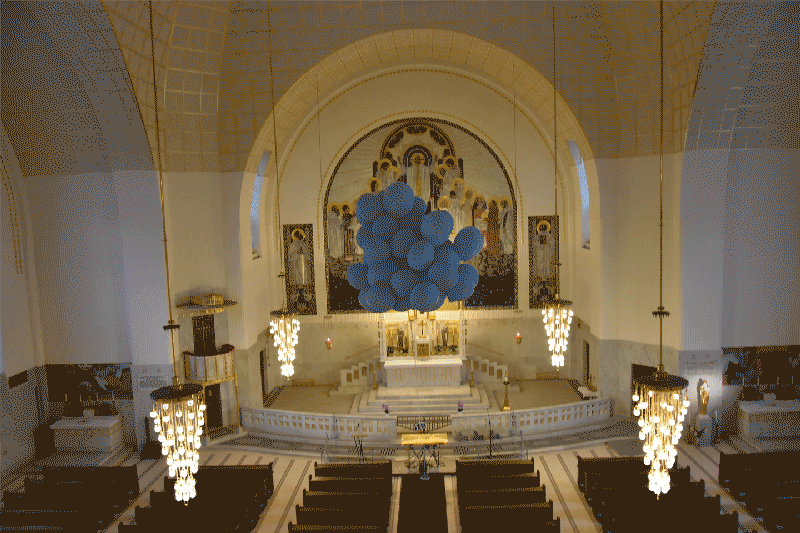
Fifty helium-filled balloons are lifting a copy of the DSM-IV (Diagnostic and Statistical Manual of Mental Disorders) used by psychiatrists. The book comprehensively describes the characteristics of a mystical experience: hearing voices, seeing visions, experiencing a sense of disassociation, a loss of sense of time and space, and an inability to articulate the experience. All of these characteristics are however described in psychopathological terms and raise the question of the place of mysticism and acute religious experience in the field of psychiatry. Even after considerable changes to both the DSM-V and the 10th edition of the Classification of Mental and Behavioural Disorders (ICD-10), it surely remains challenging for the clinician to distinguish between religious delusions as a potential expression of a psychiatric disorder, mystical experience, and positive religious coping strategies. Disturbances that have a religious dimension should not by default be viewed as pathological. The helium will not hold the book up for the duration of the exhibition. Visitors will be able to witness the weight of the book eventually bringing the balloons down to earth.
.jpg )
The imagination of a small child is so great that they can transform inanimate objects into living things. For the artist who painted these two seascapes, they are not merely representations of the sea, but ARE the sea. The two-year old artist claims that there are even fish beneath the surface. It is unfortunate that we lose the ability to imagine things into existence. Only the child and the madman can look at the world and see everything as very real and tangible. For child and the madman, there are no representations.
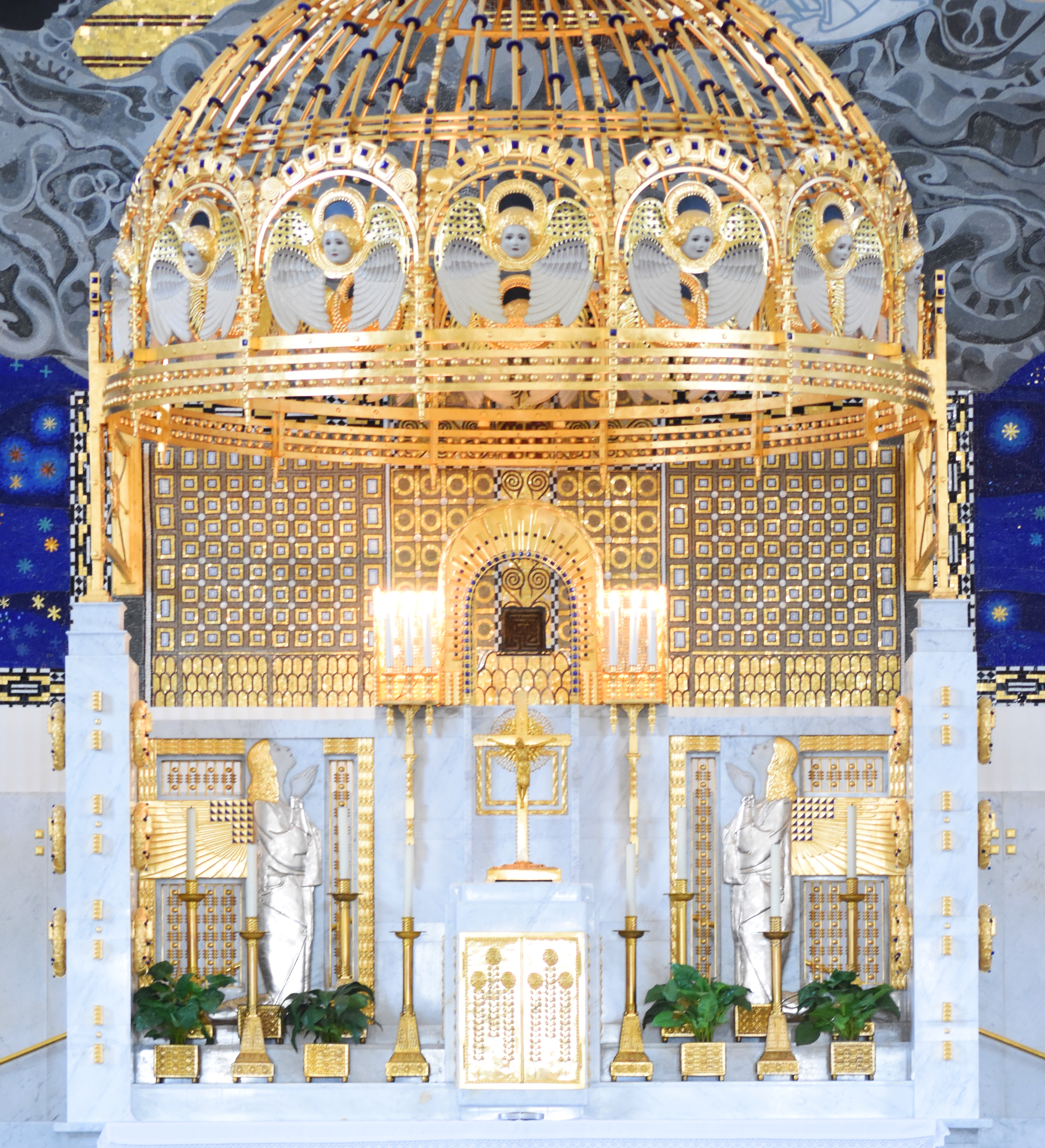
.jpg )
The artist has produced three aluminum pills coated in bronze, silver and gold. The pills are placed on the two side altars and the main high altar directly in front of the tabernacle. Through their placement on the altar, a natural association could be made between modern medicine and the Eucharist. The Eucharist was recently described by Pope Francis as “medicine for the sick” and in a sense this work is a reflection on both the sacred host as medicine and the pill as healing host. m
_(2).jpg )
This three minute video projection features photographs of details of Matthias Grünewald’s Isenheim Altarpiece. Images alternate between disturbing creatures that surround and torment the saint in the panel depicting ‘The Temptation of St. Anthony ‘and close-ups of the plants used to heal patients suffering from Ergotism (Saint Anthony’s fire) at the bottom of the panel depicting ‘St. Anthony’s visit to St. Paul in the wilderness.’ Small seedlings are placed under the volksaltar of the Kirche am Steinhof as if to be used as an offering. The plants are those depicted in the Isenheim altarpiece which were used to treat people suffering from Saint Anthony’s Fire, a condition which caused horrific hallucinations, mania and psychosis. Plaintain, Buckhorn, Verbena, Long-headed poppy and Bulbous buttercup were used to treat Saint Anthony’s fire while Austrian speedwell, Cross-leaved gentian, White swallowwart and White clover were used to treat the often foul and putrid wounds that afflicted those suffering from the condition.